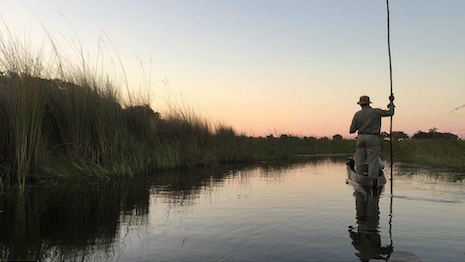The Natural Diamond Council’s Only Natural Diamonds is exploring various corners of the world with a new travel series.
The “Destination Diamonds” series provides insight into travel destinations in diamond-producing regions around the world, as the council hopes to encourage economic development through tourism in these communities. The series currently has two installments, featuring Botswana and Canada.
“Natural diamonds are found in some of the most remote, yet incredibly beautiful places on earth,” said Raluca Anghel, head of external affairs and industry relations at the Natural Diamond Council, New York. “We wanted to introduce consumers to the diversity of these regions, each with their own unique allure.
“The diamond industry is vital to the socioeconomic development of communities in these regions,” she said. “By showcasing their appeal as tourist destinations, it further builds on the economic development of these areas.”
Destination Diamonds
Each installment serves as a travel guide for the featured country, suggesting certain locales, activities, sites to see and top travel tips.
For instance, the most recent entry encourages customers to book a trip to Canada’s Northwest Territories, where they can kayak on the Great Slave Lake, go ice fishing at Blachford Lake Lodge and Wilderness Resort, dogsled through Ivvavik National Park, see the Northern Lights and dive into the history and culture of the indigenous community.
Only Natural Diamonds encourages consumers to travel to diamond-producing regions
The entry also provides affluent travelers with top travel tips for visiting the area, such as the best time to visit the Northwest Territories.
Only Natural Diamonds suggests the winter months are best for the northern lights, spring is best for ice fishing, dog-sledding and skiing and summer months are ideal for water-based activities, hikes and wildlife watching.
The debut episode and written feature focused on the Southern African country of Botswana, referring to it as the “ultimate African safari destination.”
The diamond group suggests travelers go on a safari or visit the Okavango Delta, Chobe National Park, the Makgadikgadi Pans and Orapa Game Park.
Botswana is the world’s largest producer of diamonds by value but harnesses its natural wealth for the good of its citizens and environment.
 Okavango Delta, an inland waterway that expands and contracts during the year, covering almost 8000 square miles at its peak. Image credit: Only Natural Diamonds
Okavango Delta, an inland waterway that expands and contracts during the year, covering almost 8000 square miles at its peak. Image credit: Only Natural Diamonds
“The diamond industry is a precious source of economic development, providing $16 billion in socioeconomic and environmental benefits to the countries of origin each year,” Ms. Anghel said. “Eighty percent of the value created is retained locally, and funds key infrastructure development projects as well as schools, hospitals, provides quality employment, protects vital areas for biodiversity and endangered species, as well as supports numerous social programs.
“But diamonds are a finite natural resource,” she said. “Local purchasing of goods and services, including money spent on tourism, creates a broader ‘multiplier effect,’ helping to build businesses and grow local economies such that communities will continue to thrive and be sustainable long after the closure of diamond recovery operations.”
Responsible sourcing
With such an emphasis on community and origins, “Destination Diamond” reminds consumers of a diamond’s journey. In recent years, consumer attitudes toward brand transparency and responsible sourcing have shifted drastically, increasing the demand for disclosure.
In October 2020, LVMH-owned jewelry Tiffany & Co. became the first in its industry to disclose where each diamond is crafted and set in, one year after becoming the first luxury jeweler to provide the provenance – region or countries of origin – of its individually registered diamonds (see story).
The brand also received a “strong” ranking in a report from Human Rights Watch, which assessed how jewelers’ existing certification schemes lack rigor and transparency, determining that more needs to be done to assure consumers that the jewelry they buy is sourced responsibly (see story).
British jeweler De Beers announced a list of 12 sustainability goals it plans to achieve by the year 2030, as part of its Building Forever framework, a sustainability approach embedded in the business’s commercial strategy focused on maximizing the positive impact of diamonds on their journey from discovery to retail.
By 2030, De Beers pledges to extend its best practice principles beyond its value chain to advance industry standards, provide the origin and impact of every diamond it discovers and sells and deliver scalable solutions to improve the livelihoods of artisanal miners.
In terms of partnering for thriving communities, the company plans to achieve priority UN sustainable development goals, three health targets in all its partner communities, establish skills partnerships and support four jobs across its partner countries for every one job at its operations (see story).
“As we highlight the diversity of cultures and regions where diamonds are recovered and as our consumers get the chance to actually see them first-hand, we are able to share a more accurate picture of the industry and what makes it so unique,” Natural Diamond Council’s Ms. Anghel said.
{"ct":"6\/mDNTYZRLErey4Kwa2qk3sR3FwWrygFDl6cu9KJIMU8yP28CVTL0ZM2SeG3GaRMbbmf1QqFFokBLe0dVLA7wMNkhje\/tjyjFHg+i3zijYKo3XHishFPEG8335Vp0V3v92wPuQ70P4JQ0BbkiMPeCF+V1GALVv9SzwX4hcjBQcPxG7kNSwbyLbZCj\/2dScebZ25sPZUo4kEu0eYy6qSN1w1y\/FDNm72BfKFhu40xuJBWAQb1sxFF7YIvZb6eHhwS3g\/T\/harqgLfKw021ZbRvKTrOsp8AGDi0K4vEivYK+GxxDVN+YLaq93q3n1oMTxYLBXxlWSayudHJwgIsDCQIYFPvaPf3YK4titZ1ZrhIg3ktLsotpDT0KEgu6x8KMcie5tDNf4+Cv6Bt25+cgNu6VQzsJEFefhxcm0+mEH7jCMxr2XiLbVeRafxnGNxL3cld88kQax9ByuRT1pvCPestK4Hr7DeJo+EMsg\/OsqIzgLjYH0aK6liTb57\/En6aoPJtdgIWoIZOnBtED4Lag\/cqcHi85FhQmuJzg205vXUDOrKl4tB5NbeBlZXGNuNlW8ENx11l3GjEyzzZdgD6uXGQL+M4Rw2o\/SFA0QDVJRE5OjlT\/jXgjpDXbYH7JCEyCLQtjHyEGqXfdS2oASBHLd6BhX8gJmCr06qRqIszo1OUVIafruB8k81f8Y4Olx6N1SosNEwIKqFWIEzSLrhIUjaDDONyR9BEPBajHJ65qcz+PcPF8hL\/xYRbqKdc7Bl6vxkTg4EnWymSYyhM9yMEdP8hhKzT4H3v\/AK68nzGRJJ5KG8g\/nWeGhdbc+5NNzApWfrTLX3eBgY87us1wfe6dmLVcIrmphQCM253rfWtFqBiErGLs2rvKGKJlAUjR1s9BJCmqVqhPkircnVZ\/dUCugBGhy5XvhTlsMzyGKImcnw1pFhh8nsd0NAioyif1qedrZA\/NhQ48EnQM7VlcD3a84yzYpwzNwTaPdBdWF8mn7DzqPRZT+35o\/lKhg7pSW7x0Tztuw2tQPNrtTLabrLbmyvGmu5IxKNbH286lfcqPyPARK3XXjwBq687Gtgq8OHew1LTeLPSBsh7hjXzcOGi4lnkqcsAKl\/M0Fl1F7Uqtj8ZDo5N81yEaTr84k521Kk7gbh316anntu11qoWHqtJYoQ2NkdL9U0nzWMKRy281ZlqBxujMIFqwAKhBXXOf4qS9HyHub7S9dbDnYxbM3faqvgd246OJ8Ps4DnBIPx854CnAUFPwl1uh3aWymXLCm4GA3dAn\/bYkLQ8TsLM2eO9YFOFpjv9Ecfta6D8STLoh4IR9rRq2nvLIgxjuX+VimP0UZlndaO+Q37VHxQIZK7fZ\/Hr6vXWwYP6eWvJ3CBywZrLlW3GJl8VH38FwBSReKkZeZxPW7UbDGXPTQ+B7lYhC0jchWHFGmcmi8F6c\/cfQsDCNGrNw140lBDFk1kw59htrOJczLId67iMdAyCQqrISyPZ5EsfRGTIy0Nnq3LLA14lFIgPxlWIIOXA54fGw6UssWhK+P9m3LkHFjypgWnKzLoiVWL2Q3OKXjtsP+GxririYZWco4hlGH1mJhtM4rSIpZR4nXoSgyJMk\/OtsXTdBnhtMxJiaweZEDoRDQwPHhfcnmnPcZ2xZ9zWaHh1smBtoo18sFHu5Lsi92FgDqQSpp0R5m1ASt1LuoGytOGKu4oxKuU\/NCwVu3NFY1VoYVKQnDj1JTVZokJB0DRZ2sRsAAx6QLXriK6Ev4HeYelYZ\/fUg993TTAfKp9bz\/5jRvuBBGr8UJIo\/r72ms4U4Zs05soG\/c4vNWlCw8bAaw4xTIwH0e9z425+b0V7Lw9OTKAUWfoy5WWIb+ATaqolS3VPrKgcWnvYc9SccN1+uCESQzKHAGFfDF63sI8pLESw8gx\/5vmumvHBx8qPiE90rQtbM\/Vq13lZAYKW4btglkpy7j\/PPuIY5H84KuMbT0YYDgDJ+JolN7Ppoms7cdAUw0UyJV0zpXKmNIh64GYO+qI1kt\/T\/vQ7DQlArp4uu6Uik\/0dfaFtvE0UWVTq95jlx31sqPmEN8XRuK\/PbqFPRVTDJNJBdM4rK5C2wQCpbJ2AWBLBSTNZtIvCW1g+x1lk1CCmxgUzSHkRPVs4stIebaXLvdda3WXF2YdOBHPBGMoqJzVujsfu\/VLJPyKHZmLlycO4qwC6sOo0Y2B1oDRm89NzrDnC5EyuoFdH+6ehw5eK3Si6MAax6MsOgwPNOEAz6xnPJm2ls5hP8hUOC3YhywtIENo6hCc5lQFQbhFS42vTGdLdu97G35jSXnRentR43D4eGQDtXMbTC0fFNgcchQb+blGigzXRT\/ezRChEaZeLGUZq6osvjaYgXqxUPdNh+8bBnOelH55xotq49U2gEjfkYv8YeumBA6Faj\/bTBZiDHQeJwQjv45nNBmmQTZHRBsGMM6xMTmDRg9sTF3PgbHNTeQVOsbxJTreLwEbRYB\/jPx0G8y2o2Z\/NzR4DMFk3fqwgkV93Y\/jAmOG6\/2UA8u124HnyQGCzMWIo78o67zCRTva2uBmnRxOpO5F+z8FFaGHvH6D8p5NJl4XG5QSaj8UIdWY8csjL5iUi6Q\/\/BHf7DPulxjoF7sp4LNLfxiutMlnsx45LbxdfpJ+EQKRvlALkgqGTc8JdBAJIA\/AiBb5uuXqFxoyC+dxKn4\/gNdoDCZy8tEoXVBw5bqF3WZJXogl+c01vSzHpFnY9b4XBRvKRpZ29tMsmjfdEom14q8IENMV5ljYdXG6VTjI+rwtK\/LMxOGQtLqyMVWTyQTrThHhmclsZ\/1n+KYwuT24j21haECOr6egGu5tnyKDmb6Jq72u9TYFIfU39txPMeZsxs0d6tKctaPFlCax53X6hzhtKaUyfKoTiWH8Xa8nPAjSD0HWzT5powsW0QkQYDgtk1p4nC7ptQF6aWAWLVzgi7c\/HuPt+7a13mySrCkiBNKZWMf0exLBspC2bBxwM48SG1J0Yit6XeU7e\/Ig6M3xT+uRSHyb0+KsI4y0UBWdUvHXkGvIm6vdKkUTdozUVyqVCmm2dhNtPEc4Lm+U8oMr\/iEgZ93Iejqa0\/T0W8bsG9TPwaXCc2gigOmWDhseDE1vVQIs6dfyop1x5DJwZPGE+HYJd4APwfNjzV4z9uHdgrMUFvPqttsf4EQI6M+O8ZvZ0OgeoOLksxhvr3J0a7Dm+ZAZfCsfMzShEvhakBg+if8Lp+fkMWHTLJrK15ZiNhmYTTUu5HQ3oldZqpHNOV9Jug6+qCyptTooKW4hKEe1LYOsqlGmvUX8C5cKc3TmQ9WwVwgAdhk0\/2yQFKe4qXY6jlfGOQ71PbFBWMugmDTFGU4JQsqomH4cM8VC7G2p0DwXBTIz+v3UjmrL7zvXpg84C6bnzOE+XD4Whq6bbhnhL\/g\/F7olx2FhUPxyDTJ\/bx25ITuTnW6TITyXXpYTb2wvOwsmfLVjhVVM677jj3GR6NB+G3rhWQjdR9Auc6KSwWm\/5hzhWx0UF5q19kPKFDOETeHuRggaz3ywwAPD1gV4s7k\/6S4fcYPILfr2TSBb8SXf1J+Lnc0szTWO2Nbv0b4nc3pWGKi\/yCMdv\/tC\/yrC6m9Wt3vbRNwpCak218VlcsKOFJzHlV7lIC78y9VWEkNqTNbJwiar9RvJ+CpGdQpwfq2CpjQ54+D7pwMt1Q32+\/8Wf\/Wfg7EK3QcuaZJ5cnRjedTKHAhBhERjHdedl3TMajDTCega+MmICWkvKyP+VJNq0Ny\/mREjDWDtrOBdSm4v2fO1WfbQLzurBBkJWxsEnIfaDPFWfhHdoPPwaWMhQk2PoB7wk0Ov4XXv3UDQoYP4tR7b+3Yaq4xfLmrvv4U+cb0qzMxu2RpX526Vm6Vd1APXDgxNuEuw2EDP\/YdI5xH1CWozIWOwj\/eNSE6Zu6vBP8Ova9sonRgLDFAfsuZt4E325vvUED3OPmw\/dKklKO7einVG2ERvBe0tT\/\/ZFDnDmDsI2D\/B8E3r6HTs\/cqqb8sw8poYp8XJuHmwR5eiOjic\/fLHD\/2vXyxZhFuG86qSBknzhfZogLpXn3y98lXUS4qIRAgcmad0oCJiVyaGBOrE00jR86mbZjGXHs6bhYzFp1gzGzAsjmd8a8+QwLJBw2pyynpQiZqNtyFn7wudB6y5UBnF85h29YMWh8dLdrMStCj5cKcCMuqCUjBcNN3FYSl7zoFl7YK+RJmtQUnG6FToGSoQT1hGoM\/c9TrLbq42l0VgopO5ySUbTCda0f9Wh4NCCOq9wcuhSwzFOn8uhfOFgr1ItX5ISUMpKdRyfOvVNJZSZiK\/Jhv1lWzWmaAfAPvAXi+GvHuYBCrAZ6I6rumHYRif4GePyOvyY\/vpaFbj6YrVTMROghbuGpBvr+EW37UmWnM7\/I+JfJ96niPFCa41caO0BROK+SRo0kUBziLR6EdEO3LyhHnVYkuiDF\/rv\/u5O0KMNjpitoo9j6JjjPC57NNvLIf71T3CIvYSYwSp4n9s9rRHM7zhfgOlBK0Zzkn6r+h3TS9BGJ5YFWQ1IVZdUwEsZrOU0ENYOKsJcLhv1DY0uipGA4vdOhXulF\/r98HJ1bT33\/SB\/O9F4s5Dvqxre4MWK6H1jnPiMat22qQXzcLtsfhVTxwpAxPZJoQLfD34MdbvAoupLjlaGKdCfz7E\/VwUxgZS\/xXye\/ii28v9V58nKzWW0PapdX0L4HZB1K73+Yy5\/6piwsYO1PHxZUW\/gU0HmTVdtGXXC1fxo2cdFg3L+7n8EBJ9h1ejdwwGBZ\/fdVeWSiVPfo6wE+ge1Qm7T5UprjLAWpN+nV3CNB3llmFEnD6L5yxqrzAAmUB0G0yOhVTe3rfnEABIm4Hb4CcYWWoj82epi+iTQoU94r\/qYmhEEZ3iq03+JzS9opnzdYo3SPruj7kZO+BLKf0xQoQOZlqTx1DqP0kSKP\/bnLuTMh2lzC7TO8HjWJeNeu\/C0oB0Sv1xwIoljfBDC0txeqh\/YPMDSthCIj7pQJZAiwcQDaJqQHX66ijQfcntPlEs2N4wVcH7B4zwdlyJgU4doRDZXV1gaeZgxOQr84w40f4h5Ht7QMzd0BjYkGC+ilcyACHtrQLlabuGHlc+8muI7iNdbUzC7PyUCN961hCifhC82kpfmm9ehlWa+I1r\/MdNlMV7NypOVIS98LrARa4V72t4nK6gCcWCg0gqtnpnJw7C\/2SmjhhZilxVEJuUBOsisK7NyITS6y+mzePsnVon5bLFsZHQ2yR5YLixNZyHJdXkUxZo7IAcYZipCZibJrWTwbQsZg\/De\/0NNk9HGFeA5qk7UXkLw2WEnTI29suU3cSKQwvLlOizq00XZF6G4lZGdwdd0gyXH3sYTL5sWlF12TZHI6evMRgSMvc8wnv4sTKzRA+QK7X22PCVFA8iQlvHUcS8h9d5PfrQUtr9nC8i9s5PwYPx10LIFmectxlnw4OBaf3ymfg7VR5\/tld+HhqlKJTe8+YoYypLdaWKRGvwtZkUp7lN5qLJoXzPM7n4GnEKvW6MG4R\/Yq+C\/y5M79sU\/ax+UPEMb7svyj93\/IlNqepXKBvuPAkWZVP2zfpYEpjbZNguypAzNs6afQFtzopJyO4OGY5zfDTcHjj1jHMbjQb6Cc8uKPwM\/B2nkFpCtzlc4txR20\/bC5ULA6RkICsLI1Uth0eeNL0AP3RCtiG9brfjkDTVa6U2BTB7Up0HCypEmzhAZR1r+7gWy4+SMRD09BMhSs9Ld\/PnFrL3AmTdclXzY9ltwql5neAFH3L00W+jj7EK8XNLULWQBV+ZeMAaiaIFrxxper8\/ARdGO6QV7Xnvyo2pVA0l6eErgGnaA35Bu+X450MqwqMY0QpERc+DejngBVzujI\/Kn9msrethGkZiLYdakv59YsWPSFuXtyD28xrzBHYWOVPZYljQyJ+NsJUc7LTqkmGViPmkY3Ppbd3N2JUPJ+R4zl5l5ADoPVvlBUw3wmERhbxql0Hz+Hyg9SF2CSaNUUo1g4nWue+iKKs+VVlVzdS7tbpqU+bqkAfoCE6uNjZF+dDHwGV\/tz7yFL18vb6yNUUYZ1FpmjJhp2PKaQhjEy5UiYO3nqUvyOlUT\/uhS0SFuZd39NRPGCJyR5UGKXsAfLihUF+bJ6\/AJFKGztOd7NJpzIRQO3ZATnlkayNQaRFd0brOQKidfe1YT+TdG7PL87dlOL4zcKzWbI1vwT5AMFFoswjbgY\/N93ypLdzSlSwzpler2iNW0YTpA6gGsF2BJhHgzNXGY2jjcdTQcKUs6TOFarQYbAAoDqxSrtsk+IaaF+\/x7R4Ojnp3xQUgC\/BeKbLVcLln\/l498LucdgKuCPOpivPcEYoRVSP5AUefWY8hVJMIsal\/EbpOwP9SSD+e0UpRYEBbi9P7agoJvv0DKCTxGL9uQ6UeSVDPEW5bbqpnPDuJdbIdBbCdEYFQpASycCqqGCmpI\/4BY17WLSkvThEwShWeWaI\/1yIALTV5\/HAC\/pIx0nrQdCMl4YDRq6AwvgAQ3YxP30J9oHMhd+ii1ad36lIp0egjJhT6qXh6deWx02aWDU97dGsd0qiHdjcQtz\/NamF3AVlOoyiROOBvR35hH7S1BQVwnD5ApNMg+YOGkFzbkTFA\/6mxfo40uyJP7K2iwM93tZyIS2IUPVaNnFSxB2Ah4CuKSOu2syRT1YgQeokbop+jFVtvHC\/C4BIVvKLJDa\/Pz2cMo8NFLG2ozAhDp06q8VIb2w\/jBxa+xRjyk9oQoQ4qMdSQHdo8HQx8DufBAWoE60YPcConJeG98+zG48EusHJcDbHelNr0XinzTrk7EbFsYsbOaBUZw6C85HKxyJ6UrY5wPtYIp0ZQvo7U8l7PtF3NcXoIcQUBeiZHSQrsXeE8tKerkYZZbeDht6+5KaO6C3J7pxHMPGZ7i6SO3LcYNpsKHYiiiNokaNtMzJQ0rQQfzp9n0+1pFx+9U82GiMEaCIr7UuZccbV0Ro7H6Pprwi2YqkhfHBlNi3Bh0phdpPt1RrqAAwh0bkeVkDVh\/FAGmT77rXjdFE\/\/Q1PHWEjDrpS43pcDxBxqaRUe+Ft4TkM4wCxKquFGqUWK108lfHcYZt\/WI2EF2LFplA3BaUFvDJc37wGhC2+awe9XgiRaUhEGOPVTtBgvQQp+VlSgSsBr4UDGZEXvtLPenc5DOGFuB+KYWOxx+0AOiZ0PK+YThFz4QO3Uj57\/ICw4WJfnUFwSXQQTCVoiZjukcMQf28dfh4edq6XVFX9gVUE2uS3QJrg8taI+Dv0f\/uoS3tDFbQWYgtfX7Q64erGQpW00vlzB9\/WTK9V20DQ4KnoHJW7Y5NpR4l2negIRLm3gWWydnKoz7s41dj7IqIWrxI7YZ65LL7KzoXRVaoyhDlh4BkesB2NVXIIpanhyAl1M70MYKH\/gAvgZyFoG2FDtY053RxJ\/d0+lZDe3SO1vk3y6LMTQp\/jUWpunPTKjpXW+TXDpYfSKrwluDoSdeoI1\/7ytspZMzcXLa7be8k2ShfiSh0GjBItHCQZ1+OqFxhig5Cc39ppNurf4+T5M+SoR6SZnOV1PWNNG+1YmLOKM+Mx5TePrpGdx3T7vxZ+tobADvGsiPnSqayAY+7jz\/3MoifdNU1oRdl78j+ti9OWqKHdPdYy8QhcD4PvxqI1ivQ4FOUlj4ebto8zH+gPyeeBGFY1+ezgPa76OluhSEuCqrGnVMZ84WF6aO6+rm4Q0UWCsZYSh6dVz9QMZsCN8Y+Eu2S4lsyqXSDaW+wrkyg9w8ALxdNHOtL76MNGZP3XQLJ\/K7wmG6hCCchmMxxdVXq\/qTByZfDsFGnERgHfj\/PVXqY5cBWmhcJqajTp4oSO0puWmOT51tPTlfOJWm\/S9Xqz0QeT41zuw5kSj5Mo8Usit9G7FMhIBLwpep5Zn08xvficjKK0RYzVLHUXP5w5AECYrSjaXUm3FJmtOE9nUctxSD4Ng4TOfNz\/DCmFww\/9nE8N2f6TlQtYb0x+W\/X2COhYPF+FO3GnPbrokPmG3nX9Cix9BXOTvCicrhsLaCOqKLKDgGDIXRopbtwTpiGOUkl94SCnfbar9newEnFvls6LQCO9MzS4JEUucK1I6bFyBqLfiFdyZuQXZEVO6tV45hzNWSXOOPX4Czl8nMnNtCdsUZw5vouHA46NM6K\/c2xnH7zLqHmKlnuCkOCF1XRFqsEFKi7Ng4riMkM8pc0DTE7mplMdBQUvOl8Qefrbe5IcNgD0rqFNW+7xcYalFsqL9Gk6KJdlYXUyjwgAJqGSN+PCZKpxAVq6+DMghWT83\/pH+JOcTZvm\/njB\/gV5J6TCp9KbMfYHmLC1ujXDB\/kpEyks47PNIt6IgERk5MWUjMxQ9o4pkB8vCJgEE+s61OhU+g2MsVOmgMa6ZfUBAsWChfq3tRTrO9Zf2EUgab0bXUKcuLlbg6EgbEtAB5857DVETdkDx8p0l4aJQ6BpQqD1\/5A1d4b2B0pTtrMf1G1Upt+m4VIFRVELd17kw\/rNLm3rTa2IRkn9vHLYsbqd\/CnA5mvS\/IjHAcU\/Itucekb+20iLa\/s\/UpS2SfG7oubSOWmgm4NGEHUqRBYqzpEXvTi+giP5oOTi3uCH+fft3jZN0KuKJSoEK82fqOqSFldgGD5\/r+QiyG3DGBSUIFt84KyrP3gbfnyZ53D5bfLSzZ0q9Lv8TZBBBbnurfyzEXYNM5\/OQ2qGi6eb0aM7P6V2SFFyT+SErciVtgLZw\/AEcxtCfw5+9UvohhrPUZhjm8PchsXVC1MMCPmPB68\/aGLV3N8WpY391Iq\/UXTZyhtaMmLEBfmQMNJF7VSpggBO3rcI1aBsBbI8sTIrE\/eONiQRMQY91JxQV7BvMpbvzJMuMflr8un59MoS500u6Jez+8XTjg8Lq63B0lFW4gOwWIna7zapRT69ZE5LdIFZSjxIbpOtcBPB4U0qC5DAYnFarsbicjXX0vOg+pzjkHFwgBcqpazF5Du7v3aDYrRYAi3XLYz9sBgGHbmdlATQbHJ1a1+Bdq0bNvsfpsb10IAwNDSbCKjp5X5XnGEYGF0Xpbp8oQFzf\/X26NZzXx\/X9Pa+xMBczwVc6MnBhuGzB5WsLG4zf\/JDjGiwBDhFx8wIX4pmQgSQ+ZSNR9KbqKB9rEvwHbvT0fr37ZJiA+wXpMM4\/epJ\/RJywZin+720MXTRtA4+I4BSK9yKj6RtDIuFia6Rvad\/X2yJr6Rs4cyEkb3Yr3GqhlkhhLjNNoZPTPNjo5Nmqwy352sgLNIywEyIhfe+Af10T1c9DUFoy9cBXmupJEo7jFigcWz4wpoRnVXHulKnlMvBxji65J6Ew75VoAQANw0+xNVBnfLSYq1OIeHlT+LzXVPCvydjbcUQTO1CwAjOuRz7c5QAgYYPpg2vXPPs3Gc9hYeCyhcmIVOvKONZTkRQip5YYKTbRn33FaBppeD1dsXE2aVmiZMAtvzIN6Y02Zf2D\/PnQbEIjHoB6ErXeGviBf82mX5h6MLn5mQWIaB0LrzD9zKSllwwnu49vVkjtotOgehRVKeo6Gi1+Jheihy5+8LEfP34VYzeSjiKyCiC6AUsmzLB1TQZ72ZERV4\/M","iv":"01e8751c1f953fea625521e2d9fb8c3c","s":"ac52105ffcbcfbee"}

 Covering 1.35 million square kilometers, the Northwest Territories (NWT) is a vast landscape of Arctic tundra, boreal forest and lakes. Image credit: Only Natural Diamonds
Covering 1.35 million square kilometers, the Northwest Territories (NWT) is a vast landscape of Arctic tundra, boreal forest and lakes. Image credit: Only Natural Diamonds  Okavango Delta, an inland waterway that expands and contracts during the year, covering almost 8000 square miles at its peak. Image credit: Only Natural Diamonds
Okavango Delta, an inland waterway that expands and contracts during the year, covering almost 8000 square miles at its peak. Image credit: Only Natural Diamonds